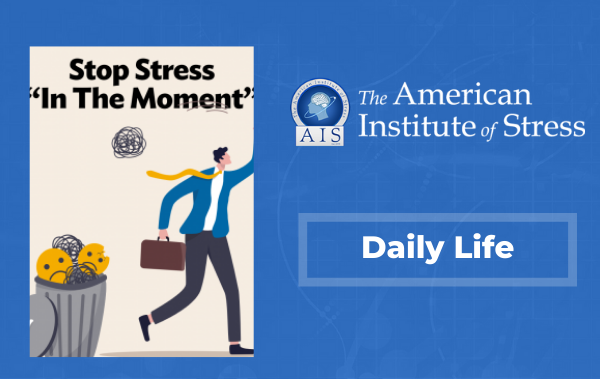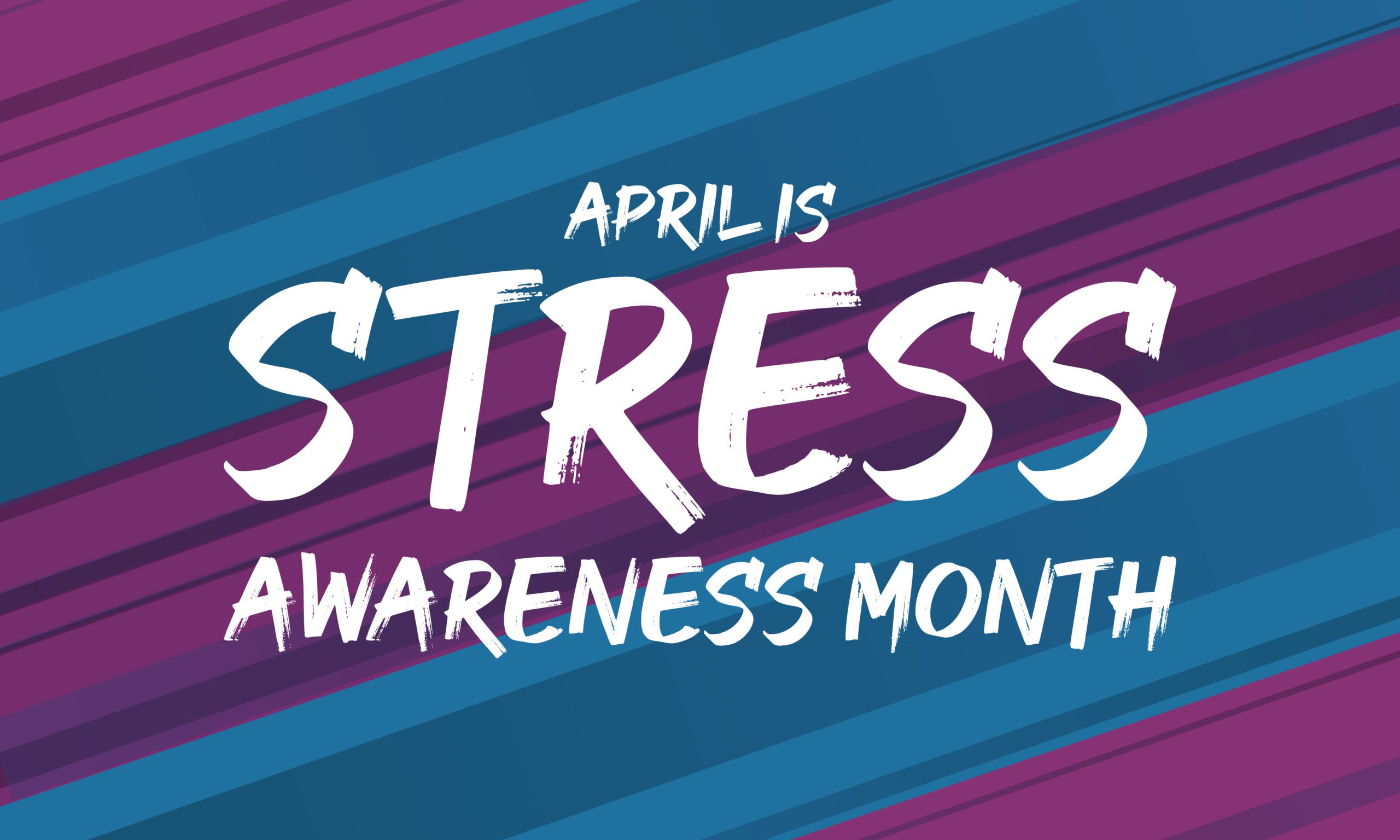*This is an article from the Spring 2022 issue of Contentment Magazine.
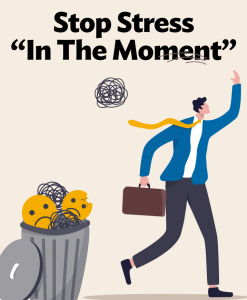
By Evian Gordon, MD, PhD, FAIS, Founder and Chief Medical Officer, Total Brain and Donna Palmer, PhD, Chief Scientific Officer, Total Brain
In this article we would like share with you the importance of stopping stress “in the moment” and the top evidence-based 5 ways to do so.
A Brain-Based View of Stress “In the Moment”
At its core, your brain is wired to automatically identify cues to avoid threats to keep you safe and identify possible rewards. This ongoing process is unconscious and occurs within a fifth of a second.1 It is the basis of your emotions, intuition, and negative/positive biases that shape many of the approximately 50,000 thoughts you have every day.
From your brain’s point of view, stress occurs when negative demands are greater than your capacity to consciously cope effectively. The gap between demand and capacity can be “acute” in the moment or can become “chronic” over time. This is considered an acute-chronic continuum. It is very well established that chronic stress is toxic to your body health, mental health, and performance.
It is now becoming increasingly evident, that the sooner stress is stopped “in the moment,” the more effectively you will control the overall cascade of stress effects. Two lines of research that shed light on the importance of reducing stress in the moment, concern emotions and homeostasis.
Firstly, any threatening cue, physical or social, can activate your safety-first stress response within a fifth of a second. The second concerns disruption of your core stress response process. Dr Lewis Coleman has recently elucidated the mechanism underlying the stress response. He highlights the importance of stopping any “over-reaction” to stress.2 Disruption of the micro-physiological details underlying any over-reaction to stress induces a cascade of negative impacts of stress and a loss of the fine tuning of the ongoing brain-body “homeostasis” (the brain-body’s healthy equilibrium).
“The stress mechanism operates continuously, efficiently, and unobtrusively to repair tissues and regulate physiology, but like any mechanism, it has limitations. When its limits are exceeded, it wastes and depletes its substrates, generates harmful or defective excesses of its products, and produces a bewildering blizzard of destructive disease effects that disrupt physiology and damage organs and tissues.”3
The opposite end of the spectrum to The Stress Response is “The Relaxation Response,” which induces a calm, more flexible brain and associated body state. The Relaxation Response helps you to cope effectively with the demands of your life.
Daily life is an ongoing fluctuation and balance between your stress and relaxation responses. Your effectiveness at managing stress is increased by understanding what emotion triggers your stress and how effectively you put a brake on your stress response and boost your relaxation response.
Figure 1. Emotional threats to our safety trigger the fight-flight stress response within a fifth of a second. Specific techniques in the moment can help activate the relaxation response and reduce the harmful effects of the stress toxicity cascade of microcellular processes.
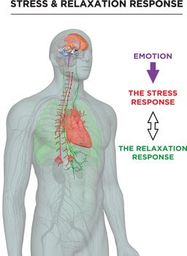
The impact that a high stress state has on you can be measured via your heartbeat patterns. When you are in a high stress state you have a faster heart rate and lower variability between the heartbeats, than when you are in a calm relaxation response state (with lower rate and increased variability between beats). A relaxation response with high variability in consecutive heartbeats is the key to a healthy adaptive effectiveness, wellbeing, improved performance and a more resilient state of being.
Figure 2 shows an example of the extent to which stress impacts your core heartbeat activity.
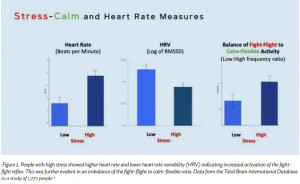
Figure 2. People with high stress showed higher heart rate and lower heart rate variability (HRV) indicating increased activation of the fight-flght reflex. This was further evident in an imbalance of the fight-flight to calm-flexible ratio. Data from the Total Brain International Database in a study of 1,772 people.4
A range of techniques have been shown to stop activation of the stress response and activate the relaxation response, in the moment. For the purposes of this article, in the moment is considered to be within 1 minute.
5 Top Ways To Stop Stress In The Moment.
- Resonant Breathing at 6 breaths a minute.
The relaxation response is switched on in-the-moment by breathing at 6 breaths per minute. This is known as “Resonant Breathing.” Most people breath at around 12 breaths a minute. The benefits of slow breathing have been known for thousands of years thanks to eastern spiritual practices. Resonant breathing adds insights from modern day science to an ancient practice.
The science shows that at a resonant breath rate, the relaxation response puts a brake on the stress response fight-flight stress system and increases activity of the Calm-Flexible Vagus system.5
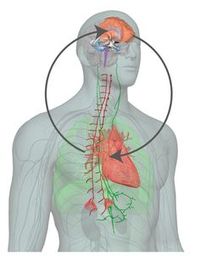
Figure 3. Resonant breathing activates the relaxation response and increases heartbeat variability in the moment.
This works to immediately reduce stress in-the-moment and create a noticeably calmer mental state for several hours, enabling you to adapt effectively to any task or situation. Resonant breathing pacing tools are available in the Total Brain platform6 or you can self-pace by counting to 4 as you breath in and count to 6 as you breath out for six breaths
in the moment. The objective impact of resonant breathing to induce calm can be readily seen using heart rate variability measures via a mobile phone camera or continuously via a digital watch wrist band or watch.

Figure 4. Objective evaluation of what’s working best for you in the moment, can be determined from heart rate variability (HRV) measures of seeing what techniques, such as resonant breathing, maximally reduce your stress level. This figure shows an example from Total Brain.com using the camera on a mobile phone to measure HRV in 40 seconds and a wrist band to measure continuous HRV updated every 6 seconds (images on the left) before and after resonant breathing (central image) to reduce stress in the moment (percentage improvement shown in image on the right).
- Repetition of ANY Stimulus.
Dr. Herbert Benson, a Harvard cardiologist, studied the significant body and brain changes of meditators and discovered something groundbreaking. Simply put: “any repetition technique will break the train of everyday thought.” For example, a repetition of slow breaths and saying a meaningful word to yourself as you exhale, or a repeating musical sound or a repeating movement, will all generate a calming relaxation response.7
Benson also points to a way for each person to find what works best for them. Choosing a word or mental association can create a deeper personal experience and induce authentic calm. Breath repetition in mindfulness techniques, slow resonant breathing at 6 breaths a minute, a positive affirmation, repetitive calm sounds, movement or entrainment music for 1 minute – all induce the relaxation response via the same repetition process.
- Practicing Presence.
Begin by focusing on the present moment. Notice your breath and senses. Use your surroundings to bring your awareness to this moment. What do you see, what do you hear? Ask yourself a simple question, “Am I fully present?” Your brain can primarily focus on one thought at a time. By switching your focus to your physical surrounding, you can induce calm in your body. You can practice during a range of daily routines – while you are walking in nature or along the street, making coffee, or just while sitting at your desk.
For a short time pay heightened attention to all sounds that you can hear around you. Welcome all sounds without judgment and be open to exploring them with a child’s curiosity. You can do the same thing with what you can feel or what you can smell. This simple practice induces your calm in the moment response and allows your brain to stop being caught up in the typical flow of overwhelming thoughts, worries and to-do lists. Focusing on your senses is a quick and simple way to become present.
- Visualization and Positive Affirmations.
“Nudge” your brain into a calmer and more positive state of being by visualizing a symbol or scene that has high emotional meaning to you. Or repeat a word that inspires and motivates you into a positive state. Because your brain’s stress and relaxation responses are triggered in a second, by purposely noticing positive things even for a moment, you are consciously nudging your core brain networks responsible for calmness and positivity to become more active.
- Any Physical Change Activity.
A brisk walk, any movement activity or moving to a different space can break negative stress thoughts and feelings and allows you to induce a more positive brain state.
In The Moment – Chronic Stress Continuum
When practiced regularly, the 5 techniques above will not only reduce stress in the moment, but they will also help to lower underlying chronic stress levels.
Other techniques have been shown to reduce chronic stress “in the long run,” including meditation, cognitive behavior therapy reframing, gratitude, curiosity, humor, music, aromatherapy, natural optimal sleep, exercise and brain healthy nutrition.
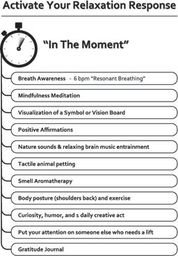
Rewire your brain-body calm though repetition. Working these techniques into your daily routine is key. Just 5-10 minutes per day as a regular practice quickly becomes a daily built-in stress coping practice. Try out different types of the options described and then continue with the ones that work best for you, and most importantly, that you will continue to include as a daily practice.
Figure 5. List of established techniques to reduce stress in the moment and into a habit in the long run.9
The best stress reduction techniques are the ones that you are most likely to continue practicing on a regular basis. Any progress is im
pactful.8 ANY practice is success. It is helpful to reduce toxic stress in any way. But it will be most transformative to your health and performance to stop stress in the moment!
References
- Gordon, E (2000). Integrative Neuroscience: Bringing together biological, psychological and clinical models of the human brain. Harwood Academic Press, London.
- Coleman, L. (2021). American Institute of Stress, Contentment Magazine, Winter Edition 2021.
- Colman, L (2021). 50 Years Lost in Medical Advance: The discovery of Hans Selye’s stress mechanism. American Institute of Stress Press.
- Total Brain Science Manual (2021), Total Brain.com.
- Szulczewski MT & Rynkiewicz A (2018). The effects of breathing at a frequency of 0.1 Hz on affective state, the cardiovascular system and adequacy of ventilation. Psychophysiology, 55(12): e13221.
- https://www.totalbrain.com/consumertrial
- Benson, H & Klipper, M.Z. The Relaxation Response. Avon, New York. 1976.
- Gordon, E., Palmer, D.M., Liu, H., Rekshan, W., & DeVarney, S. (2013). Online cognitive brain training associated with measurable improvements in cognition and emotional well-being. Technology and Innovation, 15: 53-62.
- Gordon, E (2022). The Brain: From Knowing To Doing! Franklin Media.
ABOUT THE AUTHOR
 Dr. Evian Gordon is the Founder, Chairman and Chief Medical Officer (CMO) of Total Brain. He founded the largest standardized International Brain Database (over 1 million datasets) to discover what insights and behavioral habits are most effective in stress, mental health, wellness and peak performance. He also founded https://www.totalbrain.com, an online mental health and performance platform to empower users to self-monitor and support self-care of their mental health, wellness and peak performance. Having published over 250 peer-reviewed scientific publications, Dr. Gordon is a Fellow of The American Institute of Stress (AIS) and featured in the Institute’s 2021 documentary, Mismatched: Your Brain Under Stress. Dr. Gordon is a recipient of the inaugural Royal Societies Eureka Prize for Interdisciplinary Scientific Research. He hosts the Total Brain Podcast with key opinion leaders around the world on Behavior Change. Publication details at:https://www.dreviangordon.com/
Dr. Evian Gordon is the Founder, Chairman and Chief Medical Officer (CMO) of Total Brain. He founded the largest standardized International Brain Database (over 1 million datasets) to discover what insights and behavioral habits are most effective in stress, mental health, wellness and peak performance. He also founded https://www.totalbrain.com, an online mental health and performance platform to empower users to self-monitor and support self-care of their mental health, wellness and peak performance. Having published over 250 peer-reviewed scientific publications, Dr. Gordon is a Fellow of The American Institute of Stress (AIS) and featured in the Institute’s 2021 documentary, Mismatched: Your Brain Under Stress. Dr. Gordon is a recipient of the inaugural Royal Societies Eureka Prize for Interdisciplinary Scientific Research. He hosts the Total Brain Podcast with key opinion leaders around the world on Behavior Change. Publication details at:https://www.dreviangordon.com/

————————————————————————————
Dr. Donna Palmer is a cognitive neuroscientist specializing in emotional brain functioning and integrative neuroscience. Dr. Palmer is the Chief Scientific Officer at Total Brain and a Research Affiliate of the Brain Dynamics Center, Westmead Millennium Institute and Sydney Medical School, The University of Sydney.
Contentment Magazine
The dictionary defines “content” as being in a state of peaceful happiness. The AIS magazine is called Contentment because we want all of our guests and members to find contentment in their lives by learning about stress management and finding what works best for each them. Stress is unavoidable, and comes in many shapes and sizes that makes being in a state of peaceful happiness seem like a very lofty goal. But happiness is easy to find once you are able to find ways to manage your stress and keep a healthy perspective when going though difficult times in life. You will always have stress, but stress does not always have you!
